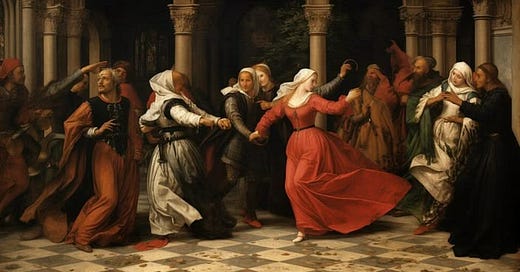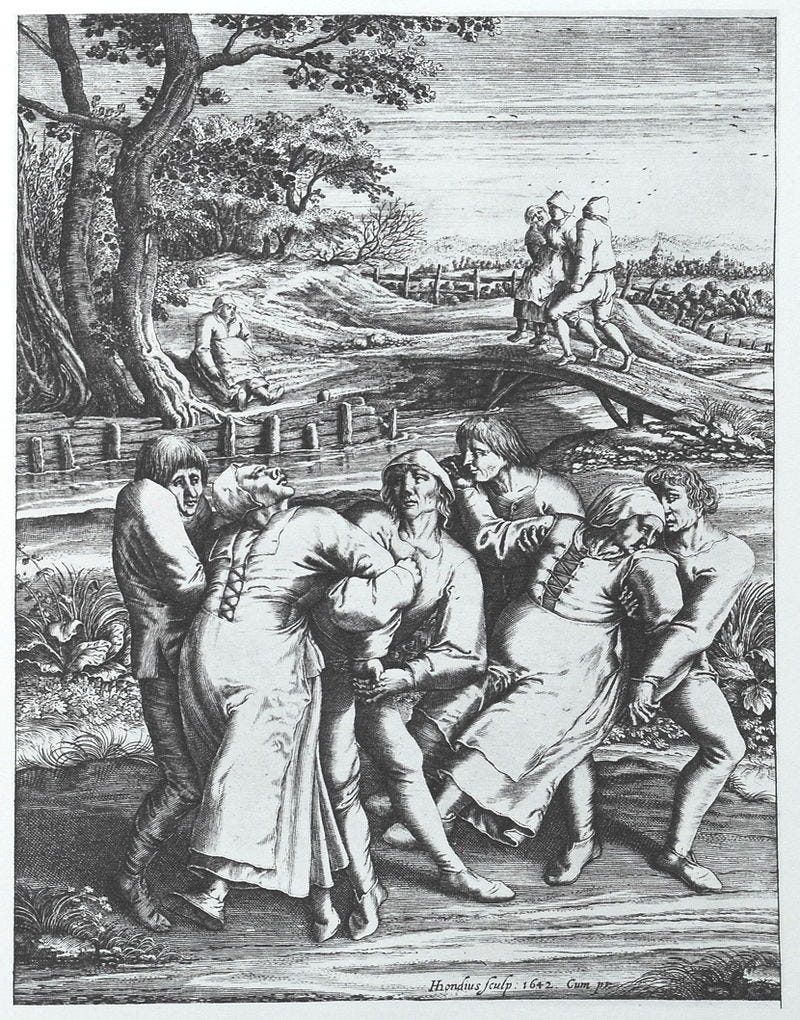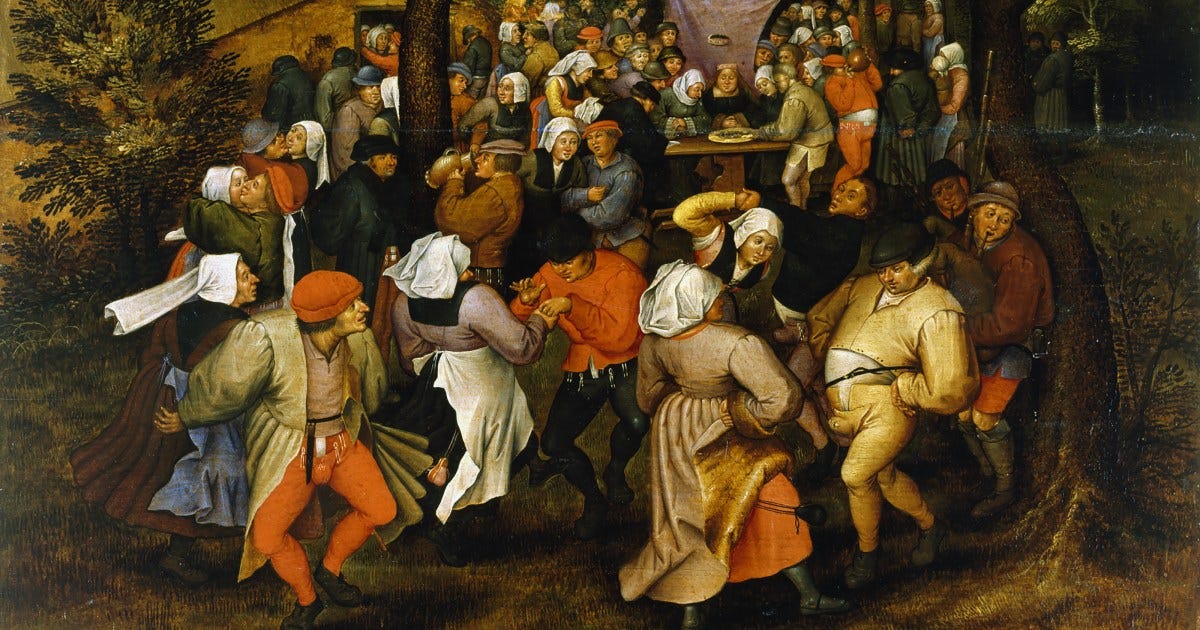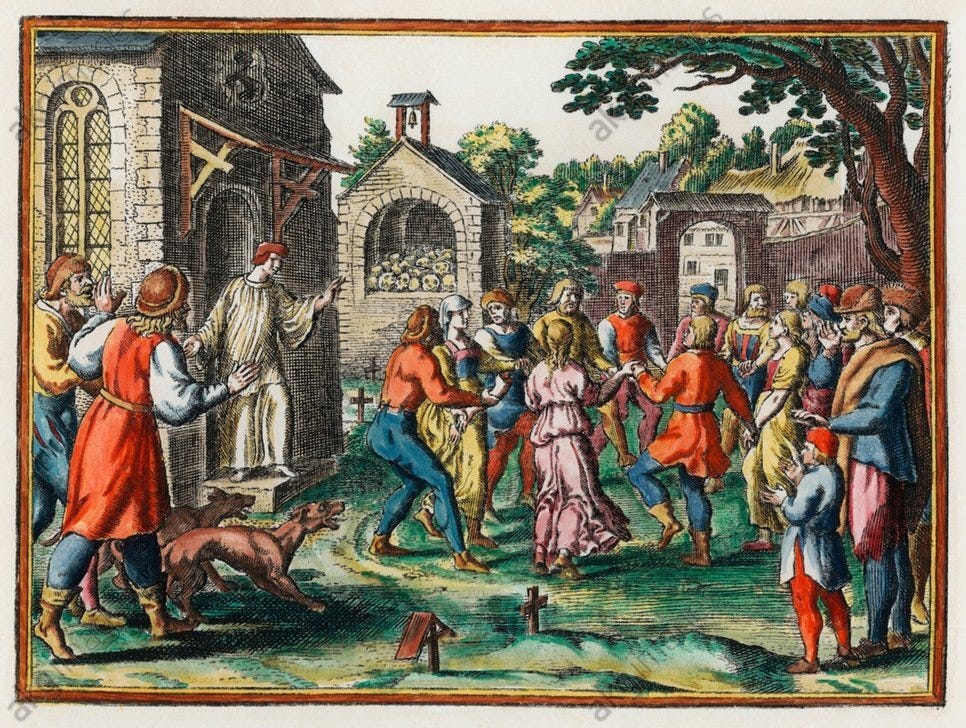Hi! My name is Kardelen. I primarily write about the Ottoman Era, which is my field of expertise, as well as the medieval period. Today's topic is a phenomenon that happened in 1518.
The outbreak of dancing mania began in July 1518 when a woman named Frau Troffea started dancing uncontrollably on a street in Strasbourg. According to Ned Pennant-Rea, ‘‘Frau Troffea began dancing on July 14th on the narrow, cobbled street outside her half-timbered home. As far as we can tell, she had no musical accompaniment—she simply began to dance.’’ Witnesses to her bizarre behavior soon began to mimic her, and within days, more than thirty people were caught in the frenzy. Some danced so relentlessly that only death could halt their movements. Troffea continued her fervent dancing for an entire week.
By August, the "dancing plague" had affected 400 people, with three dozen others joining in. Dancers were starting to fall over from exhaustion. It is said some even died from a stroke or heart attack. The victims' movements were described as spasmatic with many convulsions and their bodies were left drenched in sweat. Their arms would thrash violently and some noted that their eyes were vacant and expressionless. Blood would pool into their swollen feet and they would eventually bleed into their shoes. There were frequent cries for help from those affected. If the victims did not succumb to a heart attack, they would collapse from extreme exhaustion, hunger, and thirst. There were as many as 15 deaths per day during the outbreak’s peak, but the final number of fatalities is unknown today. No one knew what caused this reaction, so no one understood how to remedy it. By early September, the outbreak began to subside when the dancers were sent to a mountain shrine to pray for forgiveness.
The event persisted for such an extended period that it eventually captured the attention of the authorities. In response, the council relinquished control to the physicians, who advised the afflicted to ‘‘dance themselves free’’ of the mania. Accounts are suggesting that guild halls were repurposed to accommodate the dancers, complete with musicians and strong individuals to help keep the participants upright. However, this intervention backfired. The council, fearing the situation was worsening, was compelled to outlaw public dancing, as many began to fear that the mania was a divine punishment from Saint Vitus. To ‘‘rid themselves of sin,’’ large numbers of people joined the frenzied dance. The belief held that this fervent dancing, driven by either divine wrath or demonic possession, could only be stopped by those possessing divine authority, who could restore the afflicted to both physical wholeness and spiritual harmony. The council went so far as to prohibit music, but this only deepened the frenzy. In a final attempt to quell the epidemic, those who danced were ordered to visit the shrine of Saint Vitus, where they wore red shoes that had been sprinkled with holy water and marked with crosses on both the tops and soles. They carried small crosses in their hands, and the ritual was accompanied by incense and Latin incantations. Once the ritual was completed, and the participants were deemed ‘‘forgiven by Vitus,’’ word spread that the cure had succeeded. Miraculously, the Dancing Plague came to an end.
(Similar events are said to have occurred throughout the medieval period, including in the 11th century in Kölbigk, Saxony, where they were believed to be a form of divine judgment. In 15th-century Apulia, Italy, a woman was allegedly bitten by a tarantula, and the venom caused her to dance uncontrollably. The prescribed cure for the bite was to "shimmy," accompanied by specific music, a remedy widely accepted by scholars of the time, including the renowned Athanasius Kircher. Contemporary explanations included beliefs in demonic possession and the idea of overheated blood.)
Food poisoning: Many theories explain this phenomenon, with stress-induced mass hysteria being the most popular explanation, as suggested by John Waller. At the time of the events, sources from the city of Strasbourg did not provide any details on the number of deaths, nor even confirm if fatalities occurred. There seem to be no contemporary records indicating any fatalities linked to the event. Ned Pennant-Rea also suggests that the true death toll remains unknown, but if reports of up to fifteen deaths per day are accurate, the total could have reached ‘‘into the hundreds.’’ This claim largely comes from John Waller, who has published multiple journal articles and the book A Time to Dance, A Time to Die: The Extraordinary Story of the Dancing Plague of 1518. However, the sources Waller cites regarding fatalities are from later accounts of the events. Some speculate that the dancing may have been triggered by food poisoning from the toxic and psychoactive compounds of ergot fungi (ergotism), which commonly grows on grains like rye used in baking bread. Ergotamine, the primary psychoactive compound in ergot, is chemically related to lysergic acid diethylamide (LSD-25), the substance from which LSD-25 was originally synthesized. Ergot fungi have also been associated with other historical phenomena, such as the Salem witch trials. (Other theories suggest that the symptoms were similar to encephalitis, epilepsy, and typhus, but as with ergotism, those conditions cannot account for all symptoms.)
Stress: This may have been an example of fully developed cases of psychogenic movement disorder occurring within a context of mass hysteria or mass psychogenic illness, where many individuals suddenly begin displaying the same bizarre behavior. Such behavior can spread rapidly in an epidemic pattern, affecting large groups of people. This phenomenon could have been triggered by heightened psychological stress, which was exacerbated by the harsh conditions the people of Alsace endured during that time—conditions that were even more brutal than those typically seen in the early modern period. Waller suggests that the dancing may have been a form of "stress-induced psychosis" on a mass scale, considering the region’s widespread suffering from starvation and disease, combined with the deeply superstitious nature of the inhabitants. In fact, seven other instances of dancing plagues were reported in the same region during the medieval period. Deborah Hyde states that the spontaneous spread of this phenomenon through social networks played a significant role: "It’s hard to deny that the dancing mania was marked by social contagion exacerbated by stress. Outbreaks occurred along trade routes or reoccurred in the same areas – where people knew the format, in other words. Beliefs and behavior can travel just like pathogens."
Many of those affected were women, although the exact reasons for this demographic imbalance are unclear. Some theorists suggest that social and psychological pressures on women during this time may have played a role. Also, some have taken a different approach, claiming it was a form of organized religious worship characterized by mania. They argue that its proponents feigned madness to conceal intentional heretical beliefs.
That’s it, we probably will never know how exactly the event occurred and why these happen. I will continue sharing new articles about the Ottoman Era, the medieval era, and general history. Readers’ opinions are always welcomed, Take care!
Kardelen






